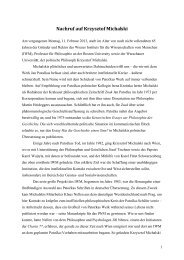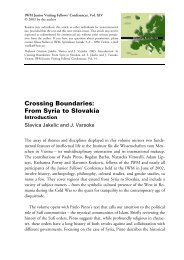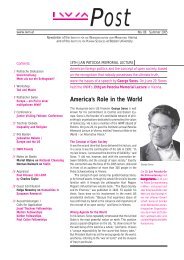Europe's Responsibility in the World of Today - IWM
Europe's Responsibility in the World of Today - IWM
Europe's Responsibility in the World of Today - IWM
Erfolgreiche ePaper selbst erstellen
Machen Sie aus Ihren PDF Publikationen ein blätterbares Flipbook mit unserer einzigartigen Google optimierten e-Paper Software.
16<br />
SEMINAR SERIES<br />
Europe or <strong>the</strong><br />
Globe?<br />
ALMOST FIFTEEN YEARS have passed s<strong>in</strong>ce<br />
1989, and as <strong>the</strong> gates <strong>of</strong> <strong>the</strong> European<br />
Union open up ra<strong>the</strong>r slowly, <strong>the</strong> countries<br />
<strong>of</strong> <strong>the</strong> former Eastern bloc have to<br />
face global challenges <strong>in</strong> <strong>the</strong>ir own ways.<br />
They are mak<strong>in</strong>g efforts to adjust to <strong>the</strong><br />
plethora <strong>of</strong> EU requirements, but also<br />
f<strong>in</strong>d <strong>the</strong>ir societies transform<strong>in</strong>g to global<br />
(US?) patterns. This tension, its sources,<br />
and its consequences are <strong>the</strong> focus <strong>of</strong> an<br />
<strong>IWM</strong> sem<strong>in</strong>ar series directed by Janos<br />
Matyas Kovacs.<br />
Sem<strong>in</strong>ar sessions <strong>in</strong> spr<strong>in</strong>g 2004 <strong>in</strong>cluded <strong>the</strong><br />
follow<strong>in</strong>g presentations:<br />
January 21<br />
Viktor Osiatynski Warsaw, law<br />
Public Policy: The Space Between Needs<br />
and Rights<br />
February 25<br />
Maja Vehovec Rijeka, economics<br />
Informal Institutions <strong>in</strong> Post-Communism:<br />
Does Bus<strong>in</strong>ess Ethics Help?<br />
April 21<br />
Tatiana Zhurzhenko Kharkiv/Vienna,<br />
sociology<br />
Nation-Build<strong>in</strong>g and Post-Soviet Borders.<br />
The Case <strong>of</strong> Ukra<strong>in</strong>e and Russia<br />
May 12<br />
Marc-Olivier Padis Paris, political science<br />
“The Mult<strong>in</strong>ationals <strong>of</strong> <strong>the</strong> Heart”.<br />
The NGOs, politics and <strong>the</strong> market<br />
May 26<br />
Natalia Pushkareva Moscow, history<br />
Fem<strong>in</strong>ism <strong>in</strong> Russia: Two Centuries <strong>of</strong> History<br />
June 16<br />
Margit Leuthold Vienna, sociology and<br />
László Neumann Budapest, sociology<br />
European Employment Strategies:<br />
Lively Policy Objectives or “F<strong>in</strong>ger-Tra<strong>in</strong><strong>in</strong>g”<br />
for Bureaucrats?<br />
Please visit <strong>the</strong> <strong>IWM</strong> website for details.<br />
KÖRBER FELLOWSHIPS<br />
In 2002, <strong>the</strong> <strong>IWM</strong> and <strong>the</strong> Koerber Foundation launched a new<br />
fellowship program on “History and Memory <strong>in</strong> Europe”. While<br />
<strong>the</strong> new Call for Application has been published recently (see<br />
page 17), <strong>the</strong> first group <strong>of</strong> fellows has now completed <strong>the</strong>ir stay.<br />
In this Newsletter Izabella Ma<strong>in</strong> presents her research project.<br />
Monumental Cityscapes <strong>in</strong> Poland<br />
Dur<strong>in</strong>g and After Communism<br />
IN THE 1980S many monuments became<br />
important sites for contest<strong>in</strong>g <strong>the</strong> Communist<br />
regime <strong>in</strong> Poland: while monuments<br />
honor<strong>in</strong>g national heroes became<br />
sites <strong>of</strong> illegal ga<strong>the</strong>r<strong>in</strong>gs, Communist ones<br />
were overtly criticized. Yet after 1989,<br />
monuments ceased to attract attention<br />
and evoke emotions. Dur<strong>in</strong>g <strong>the</strong> transition<br />
period new tensions and conflicts appeared,<br />
and both <strong>the</strong> political scene and<br />
society became more fragmented, voic<strong>in</strong>g<br />
different needs for monuments. In my<br />
project I <strong>in</strong>vestigated <strong>the</strong> relation between<br />
artifacts – erected to commemorate historical<br />
events and persons and displayed<br />
<strong>in</strong> public places – with national and local<br />
politics, and social and <strong>in</strong>dividual memory<br />
<strong>of</strong> <strong>the</strong> past.<br />
The two major questions are: how<br />
political and historical changes affected<br />
<strong>the</strong> memory landscape dur<strong>in</strong>g <strong>the</strong> 20 th<br />
and 21 st century; and, whose history and<br />
memory was materialized <strong>in</strong> <strong>the</strong> monuments?<br />
The analysis <strong>of</strong> social perception <strong>of</strong><br />
monuments, expressed by participation <strong>in</strong><br />
<strong>of</strong>ficial, illegal, or spontaneous activities as<br />
well as voiced <strong>in</strong> memoirs and <strong>in</strong>terviews,<br />
allows us to observe changes <strong>in</strong> <strong>in</strong>dividual<br />
and collective relation to history and<br />
memory. After 1989, so-called historic<br />
routes – composed <strong>of</strong> monuments and<br />
build<strong>in</strong>gs – were designed <strong>in</strong> several cities<br />
reveal<strong>in</strong>g <strong>the</strong> present representation <strong>of</strong> history.<br />
It is quite remarkable that<br />
multiethnic and multicultural heritage<br />
began to be noticed through new monuments,<br />
plaques and historic routes.<br />
Monuments erected dur<strong>in</strong>g <strong>the</strong><br />
Communist regime by no means represented<br />
a univocal version <strong>of</strong> <strong>the</strong> past. They<br />
can be classified <strong>in</strong>to four different categories:<br />
monuments honor<strong>in</strong>g Communist<br />
tradition, national movement, Holocaust<br />
victims, and social protests. The first<br />
Monument <strong>of</strong> Gratitude to <strong>the</strong> Soviet Soldiers<br />
was erected <strong>in</strong> Lubl<strong>in</strong> <strong>in</strong> August<br />
1944, at <strong>the</strong> time <strong>of</strong> Warsaw Upris<strong>in</strong>g, a<br />
hopeless fight<br />
aga<strong>in</strong>st <strong>the</strong> Nazi occupier;<br />
it was followed<br />
by <strong>the</strong><br />
Poznan Monument<br />
to <strong>the</strong> Soviet<br />
Soldiers, <strong>the</strong> Polish-<br />
Soviet Bro<strong>the</strong>rhood<br />
Monument<br />
Izabella Ma<strong>in</strong><br />
<strong>in</strong> Krakow, <strong>the</strong><br />
Len<strong>in</strong> Monument<br />
<strong>in</strong> Nowa Huta, and <strong>the</strong> Monument to Soviet<br />
Marshal Koniev (1987!). Concurrently,<br />
after 1956, national monuments<br />
were erected and pre-war monuments destroyed<br />
by <strong>the</strong> Nazis were rebuilt, e.g.,<br />
Mickiewicz, Kosciuszko and Grunwald<br />
monuments, honor<strong>in</strong>g <strong>the</strong> “progressive”<br />
national history, <strong>in</strong>corporated <strong>in</strong>to <strong>the</strong><br />
Communist tradition, and <strong>in</strong>tended as a<br />
way to legitimize <strong>the</strong> Communist regime.<br />
Monuments <strong>in</strong>itiated by Solidarity <strong>in</strong>cluded<br />
<strong>the</strong> June 1956 Monument <strong>in</strong><br />
Poznan and <strong>the</strong> Gdansk Monument, exemplify<strong>in</strong>g<br />
that even dur<strong>in</strong>g <strong>the</strong> Communist<br />
period communities could commemorate<br />
victims <strong>of</strong> <strong>the</strong> regime.<br />
In 1989, <strong>the</strong> most visible Communist<br />
monuments were removed or destroyed:<br />
<strong>in</strong> Lubl<strong>in</strong> <strong>the</strong> Gratitude and <strong>the</strong><br />
Bierut Monuments, <strong>in</strong> Kraków – <strong>the</strong> Polish-Soviet<br />
Bro<strong>the</strong>rhood and <strong>the</strong> Len<strong>in</strong><br />
Monuments, yet, many monuments to<br />
Communist heroes rema<strong>in</strong>ed. Newly constructed<br />
monuments commemorated previously<br />
controversial events as well as honored<br />
national and local heroes: monuments<br />
to <strong>the</strong> victims <strong>of</strong> Katyn, <strong>the</strong><br />
Pilsudski Monument, and numerous<br />
Pope monuments. In most cases, <strong>the</strong> debates<br />
about post-1989 monuments concerned<br />
<strong>the</strong>ir location, an artistic form, and<br />
an unveil<strong>in</strong>g ceremony, yet <strong>the</strong> decisions<br />
were <strong>of</strong>ten made by local authorities under<br />
<strong>the</strong> pressure <strong>of</strong> various associations.<br />
As a sign <strong>of</strong> a relative tiredness with<br />
political arguments less solemn statues ap-<br />
<strong>IWM</strong> NEWSLETTER 84 Spr<strong>in</strong>g 2004/No. 2



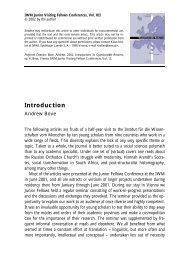
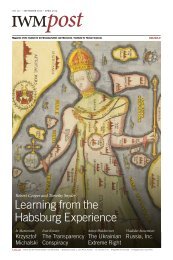
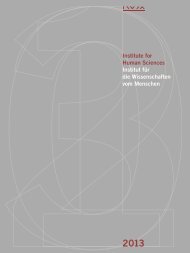

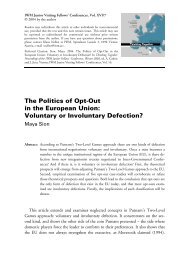

![POSZUKIWAÅ PRAWDY I ZABAWY [PODPIS] PROF ... - IWM](https://img.yumpu.com/23611273/1/184x260/poszukiwaa-prawdy-i-zabawy-podpis-prof-iwm.jpg?quality=85)
